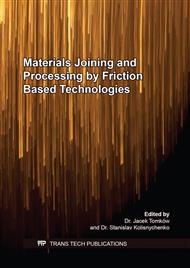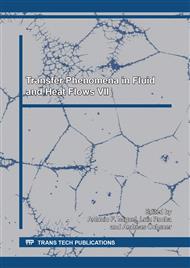[1]
H. Xiaocong, G. Fengshou, B. Andrew, Progress in Materials Science. 65 (2014) 1–66.
Google Scholar
[2]
R. Mishra, Z. Ma, Friction stir welding and processing, Mater. Sci. Eng. R50 (2005) 1–78.
Google Scholar
[3]
R. Nandan, T. DebRoy, H.K.D.H. Bhadeshia, Recent advances in friction-stir welding – process, weldment structure and properties, Prog Mater Sci. 53 (2008) 980–1023.
DOI: 10.1016/j.pmatsci.2008.05.001
Google Scholar
[4]
P. Threadgilll, A. Leonard, H. Shercliff, P.J. Withers, Friction stir welding of aluminum alloys, Int Mater Rev. 54 (2009) 49–93.
Google Scholar
[5]
G. Çam, Friction stir welded structural materials: beyond Al-alloys, Int Mater Rev. 56 (2011) 1–48.
DOI: 10.1179/095066010x12777205875750
Google Scholar
[6]
S. Guerdoux, L. Fourment, A 3D numerical simulation of different phases of friction stir welding, Modelling Simul. Mater. Sci. Eng. 17 (2009) 075001 (32pp).
DOI: 10.1088/0965-0393/17/7/075001
Google Scholar
[7]
M. Assidi, L. Fourment, S. Guerdoux, T. Nelson, Friction model for friction stir welding process simulation: Calibrations from welding experiments, International Journal of Machine Tools & Manufacture 50 (2010) 143–155.
DOI: 10.1016/j.ijmachtools.2009.11.008
Google Scholar
[8]
C. Hamiltona, S. Dymekb, A. Sommersa, A thermal model of friction stir welding in aluminum alloys, International Journal of Machine Tools & Manufacture 48 (2008) 1120–1130.
DOI: 10.1016/j.ijmachtools.2008.02.001
Google Scholar
[9]
Z. Feng, X. Li Wang, S. David, P. Sklad, Modeling of Residual Stresses and property distributions in friction stir welds of aluminum alloy 6061-T6. Oak Ridge National Laboratory, Oak Ridge, 37831.
DOI: 10.1179/174329307x197610
Google Scholar
[10]
O. Frigaard, O. Grong, J. Hjelen Gulbrandsen-Dahl, O. Midling, Characterization of the subgrain in friction stir welded aluminium alloys using the SEM–EBSD technique, Proceeding 1st International Symposiuom in Friction Stir Welding, The welding institute, Thousand Oaks, CA (1999).
DOI: 10.4028/www.scientific.net/msf.426-432.2861
Google Scholar
[11]
H. Schmidt, T. Dickerson, J. Hattel, Material flow in butt friction stir welds in AA2024-T3, Acta Mater. 54 (2006) 1199–1209.
DOI: 10.1016/j.actamat.2005.10.052
Google Scholar
[12]
A. Gerlich, M. Yamamoto, T. North, Strain rates and grain growth in Al 5754 and Al 6061 friction stir spot welds, Metall. Mater. Trans. A 38 (6) (2007) 1291–1302.
DOI: 10.1007/s11661-007-9155-0
Google Scholar
[13]
M. Guerra, C. Schmidt, J. McClure, L. Murr, A. Nunes, Flow patterns during friction stir welding, Mater. Charact. 49 (2002) 95–101.
DOI: 10.1016/s1044-5803(02)00362-5
Google Scholar
[14]
P. Ulysse,Three-dimensional modeling of the friction stir-welding, Process Int. J. Mach. Tools. Manuf. 42 (2002) 1549–1557.
DOI: 10.1016/s0890-6955(02)00114-1
Google Scholar
[15]
P. Colgrove, H. Shercliff, 3-Dimensional CFD modeling of flow round a threaded friction stir welding tool profile, J. Mater. Proc. Technol. 169 (2005) 320–327.
DOI: 10.1016/j.jmatprotec.2005.03.015
Google Scholar
[16]
K. Jata, M. Mahoney, R. Mishra, S. Semiatin, D. Field (Eds.), Friction Stir Welding and Processing, TMS, Warrendale, PA (2001) 43–54.
Google Scholar
[17]
J. Lienert, W. Stellwag, B. Grimmett, R. Warke, Friction Stir Welding Studies on Mild Steel, Welding Journal 82(1) (2003) 1s-9s.
Google Scholar
[18]
D. Failla II, Friction Stir Welding and Microstructure Simulation of HSLA-65 and Austenitic Stainless Steels, Welding Engineering MS Thesis at the Ohio State University, (2009).
Google Scholar
[19]
R. Nandan, B. Prabu, A. De, T. Debroy, Improving Reliability of Heat Transfer and Materials Flow Calculations during Friction Stir Welding of Dissimilar Aluminum Alloys, Welding Journal. 86 (2007) 313-s, 322-s.
DOI: 10.1201/9781315116815-4
Google Scholar
[20]
ABAQUS 6.14.2. Finite Element Software, 2014. Simulia ABAQUS®, Inc.
Google Scholar
[21]
M. Mehta, K. Chatterjee, A. De, Monitoring torque and traverse force in friction stir welding from input electrical signatures of driving motors, Science and Technology of Welding and Joining. 18 (3) (2013) 191-197.
DOI: 10.1179/1362171812y.0000000084
Google Scholar
[22]
R. Nandan, G. Roy, T. Lienert, T. Debroy, Three-dimensional heat and material flow during friction stir welding of mild steel, Acta Materialia 55 (2007) 883-895.
DOI: 10.1016/j.actamat.2006.09.009
Google Scholar
[23]
G. Dieter, Mechanical Metallurgy, McGraw-Hill, New York, Sec. 18-6 (1986) 483-484.
Google Scholar
[24]
SYSWELD-Visual Weld material data base. Material Database Manager, (2011).
Google Scholar
[25]
J. Hatel, Thermomechanical Modelling of Friction Stir Welding, Trends in Welding Research Proceedings of the 8th International Conference, S. David, T. DebRoy, J. DuPont, T. Koseki, H. Smartt, Editors (2009) 1-10.
Google Scholar
[26]
E. A. Bonifaz, Finite Element Analysis of Heat Flow in Single-Pass Arc Welds, Welding Journal. 79 (5) (200) 121-s – 125-s.
Google Scholar



